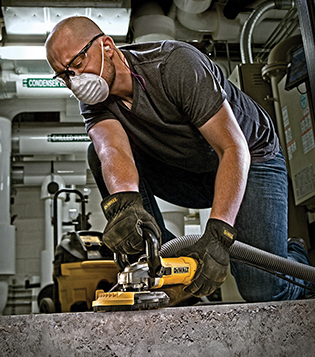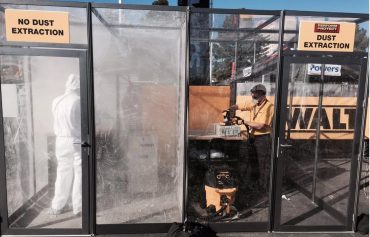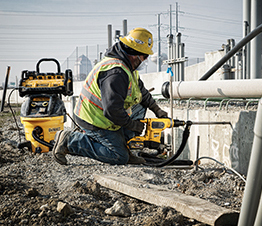
John Bleasby
U.S. silica rules are coming to Canada! Here’s what you need to know.
Canadian ContractorB.C. leads Canada with containment protocols, as tool manufacturers offer new solutions

DeWalt now offers shroud and hose adapters that connect to their HEPA dust and silica extractors, meeting the latest OHSA silica guidelines
After years of haggling between industry and regulators, new interim guidelines issued by the U.S. Occupational Health and Safety Administration (OHSA) concerning worker exposure to silica dust are now being enforced south of the border. It was thought just a few months ago that industry critics of the initiatives, together with the Trump administration, would push back against the new silica regulations citing increased costs and bureaucratic burdens. However, companies now have 30 days to comply under the new guidelines or face fines and citations. Industry and equipment manufacturers are also adjusting to the new reality.
What is silica and where does it comes from?
Silica is the base component of sand and rock, and is therefore found in construction work that involves concrete, concrete block, cement, and mortar, masonry, tiles, brick, and refractory brick, granite, sand, fill dirt, and top soil, asphalt-containing rock or stone, and abrasives used for blasting. That’s a pretty comprehensive list, covering many tasks that take place on a site such as chipping, sawing, grinding, hammering, or drilling, crushing, loading, hauling, or dumping, building demolition, power cutting or dressing stone, facade renovation, including tuck-point work, abrasive or hydro blasting, dry sweeping or pressurized air blowing, tunneling, excavating, or earth moving. No one should feel left out!

This dramatic demonstration shows the effectiveness of using a silica and dust extraction system versus nothing at all
How does silica affect workers’ health?
According to Worksafe BC, “Inhaling silica dust can cause silicosis, a serious and irreversible lung disease. It can be lethal. Silica damages the lung and causes scar tissue to form. This causes the lung tissue to become thicker. Silica exposure can also cause lung cancer.” Although symptoms may not appear at first, exposure to silica over time can result in shortness of breath, severe coughing and body weakness.
Rethinking site conditions to reduce silica
Contractors can consider a few immediate steps to reduce their workers’ exposure to silica. Worksafe BC suggestions include using alternate materials that contain less or even no silica, design changes to reduce the amount of concrete forming taking place, using water to mitigate dust, and installing localized ventilators. Posting warning signs, rescheduling unrelated workers so they can avoid exposure, and improving washing facilities can also be considered.
Inspectors are already on the loose
According to a media report, inspectors in British Columbia began visiting construction sites in mid-summer, monitoring dust levels and issuing warnings concerning silica exposure. One contractor was informed about the requirement to have an assessment by a qualified individual ahead of work commencing. While subsequent visits indicated that the contractor was working towards compliance, the incident does give contractors everywhere a preview of what might be expected by provincial health and safety inspectors in the future.

DeWalt’s HEPA dust and silica extractors, although corded, can be powered through the DeWalt portable power station with FlexVolt batteries while cordless tools do the work. That brings silica extraction to every corner of the site.
Equipment manufacturers respond with dust extraction solutions
The OHSA guidelines also address specific issues that impact tool and dust extraction design. DeWalt, for example, has already come forward with tools and systems as part of their ‘Perform & Protect’ design concept. Addressing the issue of dust and silica outlined by the OHSA guidelines, DeWalt’s dust extraction system is based on two models of HEPA dust extractors, both meeting the stringent OSHA requirements.
Each model of extractor has a filter with 99% or greater efficiency an auto-clean filter. A crush proof hose connects to tool shrouds by means of a special series of ‘AirLock’ adaptors, covering a vast range of DeWalt corded and cordless tools that cut, grind, install fasteners, or hammer into concrete work. For ease of use and compliance, DeWalt extractors have variable speed controls that activate the tool and the extractor simultaneously. The DeWalt system will, according to the company, decrease the potential of inhaling dust and increase visibility and reduce cleanup and maintenance costs.
Those contractors working with concrete and foundation work, or otherwise have exposure to silica, should consider their future tool procurement with the U.S. OHSA silica guidelines in mind. They are coming this way!
Follow John on Instagram and on Twitter for notifications about his latest posts

Advertisement
Print this page

This is a game changer. Concrete products are the basis of most commercial construction and foundation work for residential. If these initiatives are not dealt with common sense… silica will be treated like asbestos in time.
The BCCSA has developed the Silica Control Tool as a resource for the construction industry in BC. The Tool assists employers in conducting appropriate risk assessments and implementing effective controls and safe work practices where silica dust may be an occupational hazard.
http://www.silicacontroltool.com